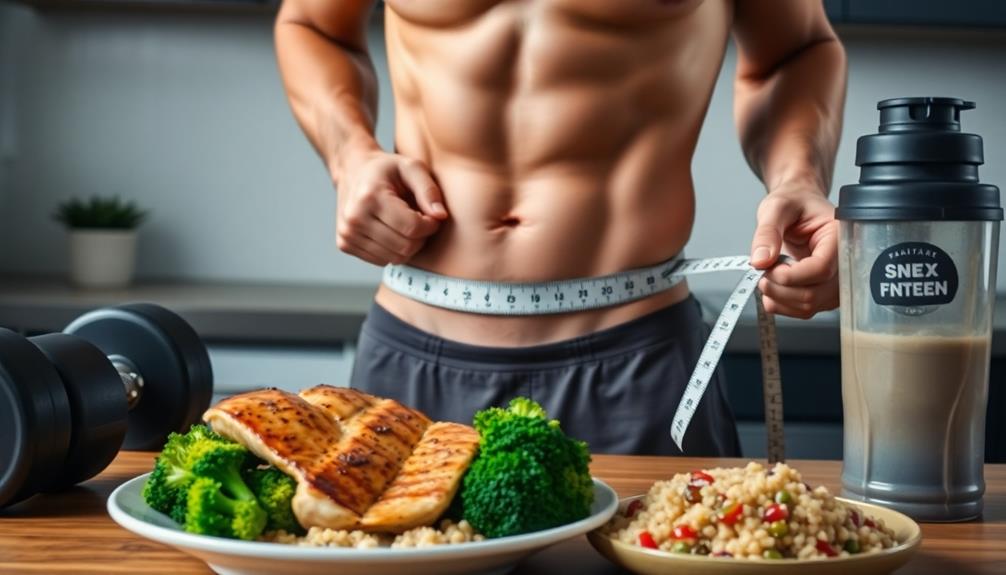To optimize protein intake during cutting, aim for 1-1.2 grams of protein per pound of body weight daily. Spread your intake across 4-6 meals, consuming 20-40 grams each time. Focus on high-quality sources like lean meats, fish, and egg whites. Time your protein intake strategically, including pre and post-workout meals, and consider a slow-digesting protein before bed. Balance your protein with healthy fats and complex carbs to support muscle retention and overall health. Don't forget to adjust your intake based on progress and performance. Proper protein management can make a significant difference in preserving your hard-earned muscle mass while shedding fat.
Core Insight
- Consume 1-1.2 grams of protein per pound of body weight, adjusting based on workout intensity and cutting aggressiveness.
- Distribute protein intake across 4-6 meals daily, with 20-40 grams per meal or snack.
- Include high-quality protein sources like lean meats, fish, egg whites, and plant-based options rich in essential amino acids.
- Time protein intake strategically, especially before and after workouts, and before bed for overnight muscle maintenance.
- Balance protein intake with appropriate amounts of complex carbohydrates and healthy fats to support overall nutrition and performance.
Understanding Protein's Muscle-Sparing Effects
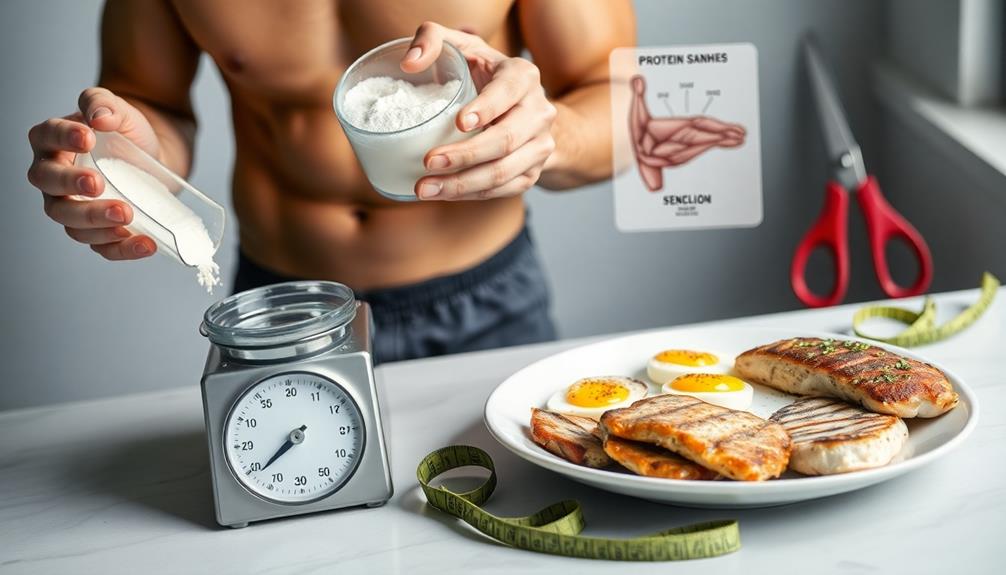
Protein is crucial when cutting for three reasons. First, it helps keep your muscles from shrinking. When you eat fewer calories, your body might start using muscle for energy. Eating enough protein stops this, so you don't lose the muscle you worked hard for. Some supplements, like Nugenix Total-T, can boost testosterone and help you maintain lean muscle during a cut.
Second, protein makes your body burn more calories while digesting it compared to fat or carbs. This revs up your metabolism, helping you lose fat.
Finally, protein keeps you feeling full longer. This makes it easier to stick to your low-calorie diet by reducing hunger and cravings.
Knowing how protein spares muscle will help you eat the right amount during a cut. This way, you can maintain muscle while losing unwanted fat.
Calculating Your Cutting Protein Needs
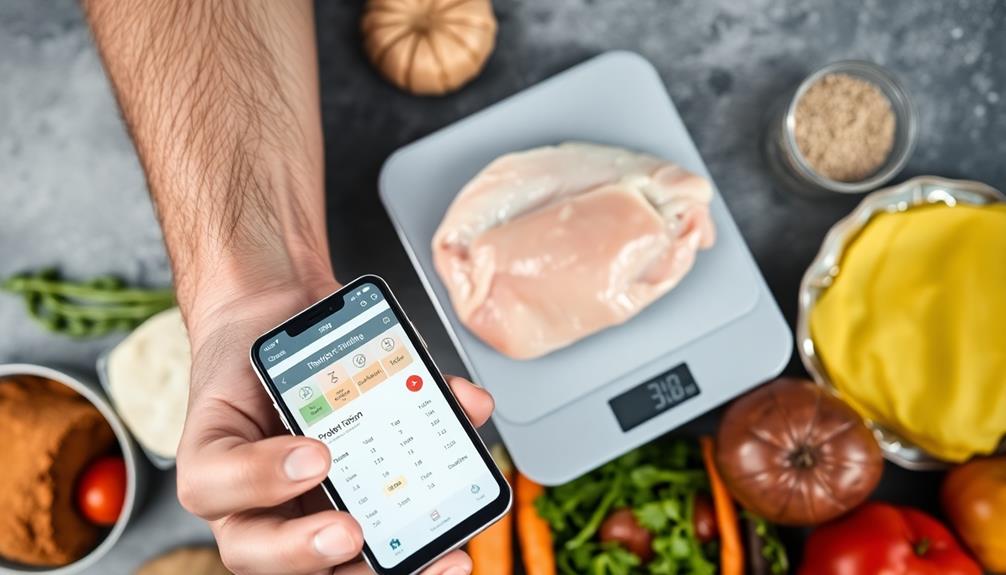
Cutting Protein Needs: How Much Should You Eat?
Figuring out your protein needs when cutting can be tricky. It depends on your weight, how active you are, and how much you're cutting calories. A good starting point is to eat 1 gram of protein per pound of body weight. If you're hitting the gym hard or cutting calories aggressively, bump that up to 1.2 grams per pound. Some athletes even take supplements like HMB to help hold onto muscle while cutting. Getting your protein intake right can make a big difference in your results.
So, let's say you weigh 180 pounds. You'd want to shoot for 180-216 grams of protein each day. But remember, this is just a starting point. Keep an eye on your progress and tweak as needed. If you're losing strength or muscle too fast, try eating a bit more protein. If you're having trouble sticking to your calorie deficit, you might need to scale back slightly.
The key is to find the right balance for you. Pay attention to how you feel and perform. With a little trial and error, you'll dial in your optimal protein intake for cutting.
Timing Protein Intake Strategically

When cutting, it's important to time your protein intake wisely. This can help you keep muscle and recover better. Eat protein 4-6 times a day, with 20-40 grams at each meal or snack. Grass-fed whey protein is a great choice because it has high-quality amino acids that support your muscles when you're eating less.
Eat a protein-rich breakfast to get your muscles growing right away. Have protein before and after workouts too. A pre-workout snack gives you energy, and post-workout protein helps you recover.
Don't forget about protein at night. A slow-digesting protein like casein before bed can help you maintain muscle while you fast overnight. This way, your muscles always have amino acids to help them stay strong and recover, even while you sleep.
Choosing High-Quality Protein Sources
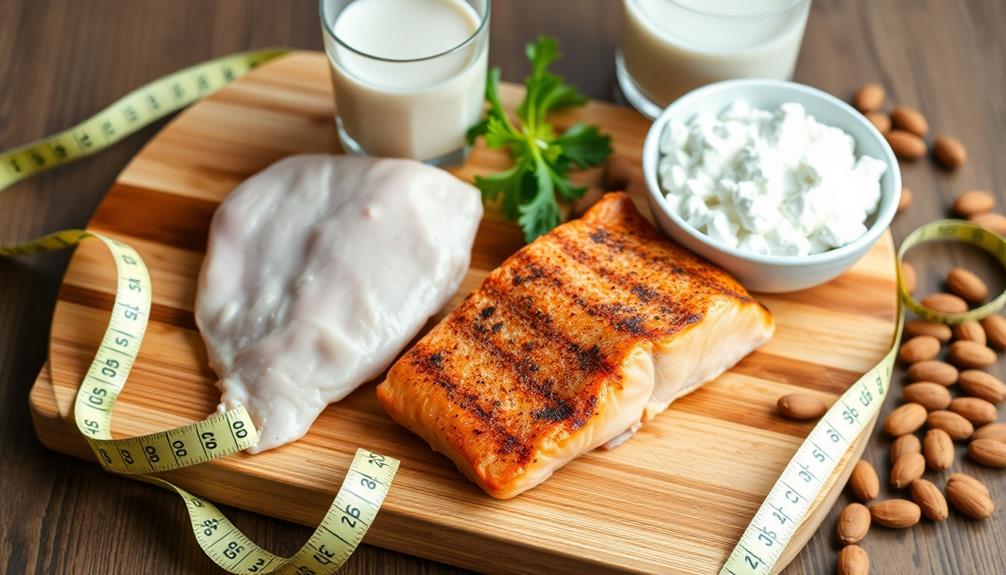
When you're cutting, the quality of your protein sources is just as important as how much you eat. Focus on lean proteins that give you all the essential amino acids. These proteins usually have more protein per calorie, which helps you keep muscle while eating fewer calories. How well your body can use the protein is also key when choosing sources.
Top protein sources to choose:
- Lean meats like chicken breast, turkey, and lean beef
- Fish such as salmon, tuna, and cod
- Egg whites, which are low in fat and can be used in many ways
Tofu, tempeh, and legumes are also great plant-based options, especially when mixed to make complete proteins. Don't forget to look at the overall nutrients in your protein sources, as they'll give you micronutrients during your cut, too.
Balancing Protein With Other Macronutrients
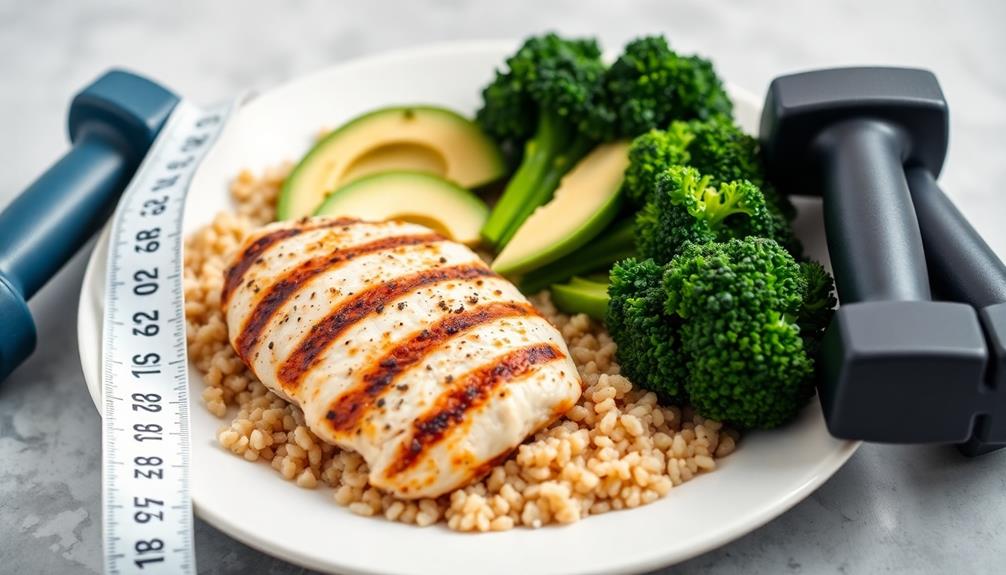
Protein is important when cutting, but don't forget about other macronutrients. You need a balance to keep your energy up and stay healthy. Carbs fuel your workouts and prevent muscle loss. Fats are necessary for hormones and absorbing nutrients. If you're sensitive to gluten, gluten-free protein powders can help you get enough protein without causing problems.
Here's how to balance your macros:
- Eat 1.6-2.2 grams of protein per kilogram of body weight.
- Get 15-30% of your calories from healthy fats.
- Use complex carbs for the rest of your calories.
Supplementation During Cutting Phases
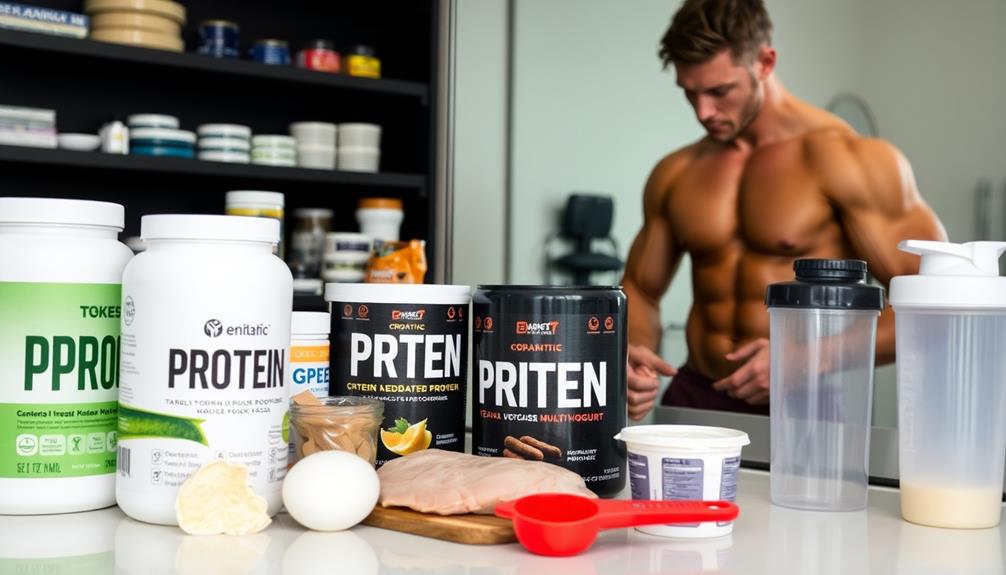
Certain supplements can help you during a cutting phase when combined with a good diet and exercise plan. Protein powder can assist in reaching your daily protein goals, especially when it's hard to get enough from food alone. BCAAs may help you keep muscle and recover better while cutting calories. Micronized creatine powder is a great choice for keeping your strength and muscle fullness during a cut because it absorbs better and mixes well. When buying creatine, choose products without fillers or additives to ensure they work best.
Keep these important things in mind when thinking about cutting supplements:
- Go for quality: Pick well-known brands that have third-party testing
- Timing matters: Take supplements strategically, especially around workouts
- Don't overdo it: Supplements should add to your diet, not replace whole foods
Creatine monohydrate can assist in maintaining strength and muscle fullness while cutting. Fish oil provides important omega-3 fats that may help with fat loss and reducing inflammation. Always remember that supplements should be an addition to your diet, not a replacement for real food. Before starting any new supplements, talk to your doctor or a healthcare professional.
Monitoring Progress and Adjusting Intake
Tracking your progress and adjusting protein intake is key when cutting. Each week, check your weight, body fat, and strength. If you're losing muscle too fast, bump up your protein by 0.1-0.2g per pound. If fat loss slows down, try reducing calories a bit while keeping protein high. Quick protein sources like energy bars can help you power through cuts.
Listen to your body during workouts and daily life. Constant fatigue or lingering soreness may mean you need more protein. Log your food to stay on target with protein. As your body changes, keep reassessing your protein needs. Stay on top of it, and you'll keep your muscle while getting lean.
Common Protein Mistakes to Avoid
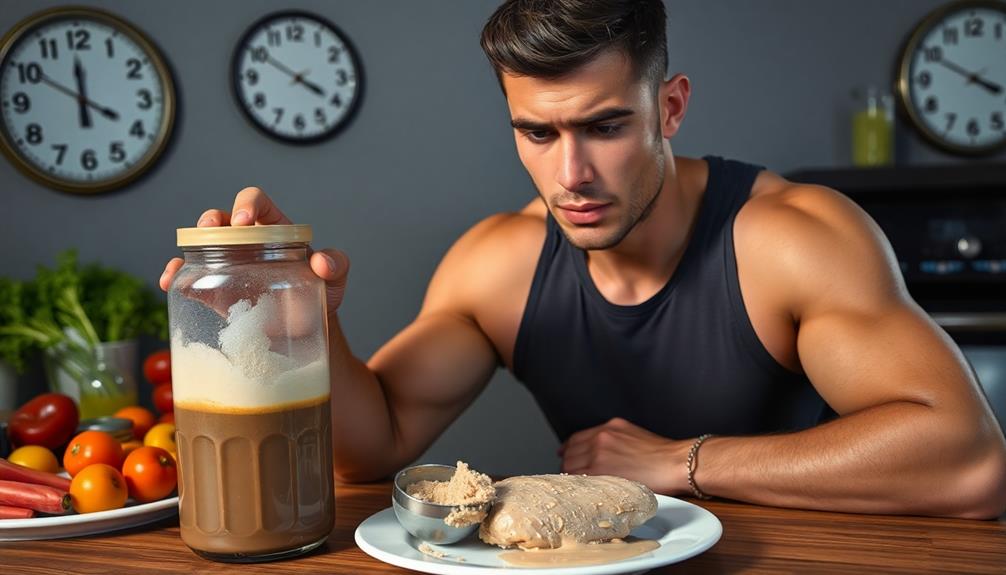
When trying to lose fat, many people make mistakes with protein that can slow their progress. Watch out for these common issues:
- Not eating enough protein: This can cause muscle loss while in a calorie deficit.
- Bad timing: Spreading protein unevenly through the day may reduce muscle growth.
- Focusing only on supplements: Protein powders and bars are convenient, but whole foods provide better overall nutrition.
Quick and easy protein sources like low-sugar protein bars can keep your energy up when cutting, especially after a workout or when you're busy.
To get the most from protein during a cut, aim for 1.6-2.2 grams per kilogram of body weight each day. Split this across 4-6 meals, choosing high-quality options like lean meats, fish, eggs, and dairy. Mix in plant proteins too, such as beans and quinoa, for added nutrients. By avoiding these mistakes, you'll keep more muscle while hitting your fat loss goals.
Frequently Asked Questions
Can Vegetarians or Vegans Effectively Optimize Protein Intake During Cutting Phases?
Yes, you can effectively optimize protein intake as a vegetarian or vegan during cutting phases. Focus on high-quality plant proteins like legumes, quinoa, and soy products. Supplement with vegan protein powders if needed to meet your daily requirements.
How Does Age Affect Protein Requirements for Muscle Retention While Cutting?
As you age, you'll need more protein to maintain muscle while cutting. Your body's ability to use protein decreases, so you should increase your intake. Aim for 1.2-1.6 grams per kg of body weight daily.
Are There Any Potential Side Effects of High Protein Intake During Cutting?
You may experience digestive issues like constipation or bloating with high protein intake. It can also strain your kidneys, increase dehydration risk, and cause bad breath. Monitor your body's response and adjust intake if needed.
How Does Sleep Quality Impact Protein Utilization During a Cutting Phase?
Your sleep quality greatly affects protein utilization during cutting. When you're well-rested, your body efficiently uses protein for muscle repair and growth. Poor sleep can hinder this process, potentially leading to muscle loss and slower recovery.
Can Intermittent Fasting Be Combined With Optimized Protein Intake for Cutting?
Yes, you can combine intermittent fasting with optimized protein intake for cutting. It's essential to plan your eating window carefully, ensuring you're consuming adequate protein when you do eat to support muscle retention during fasting periods.

